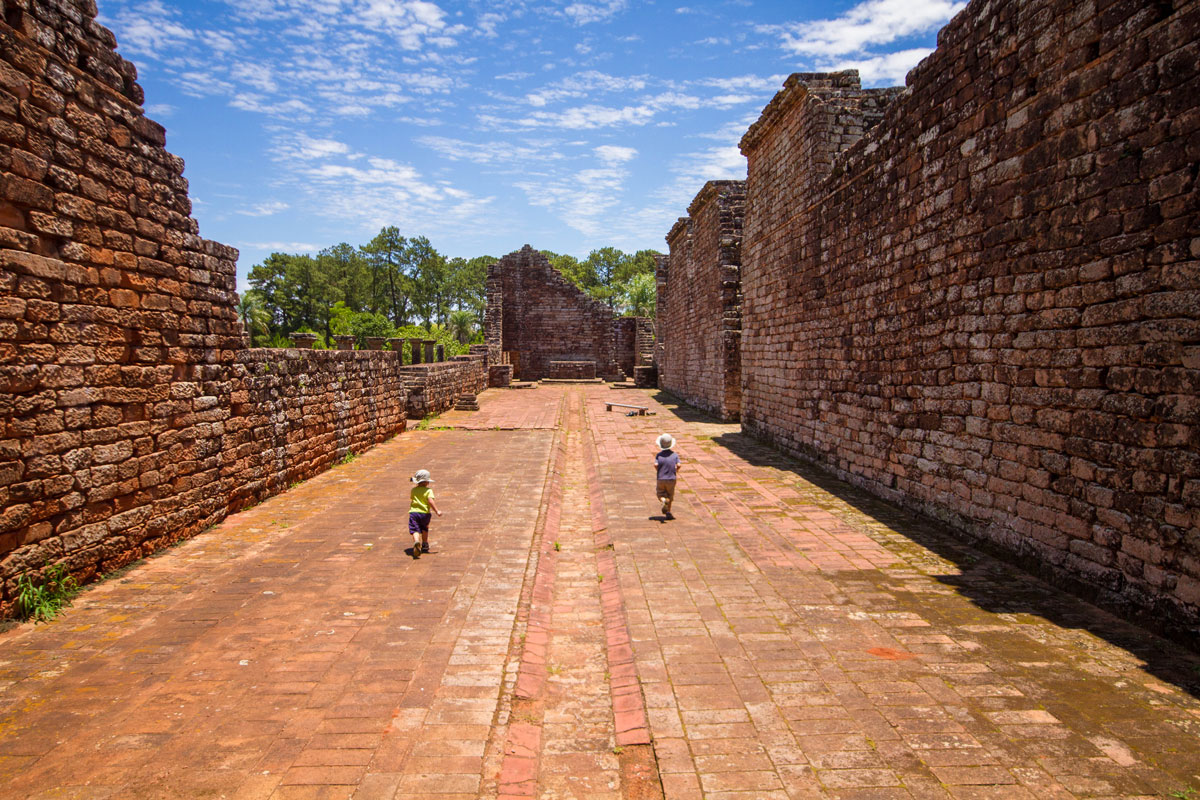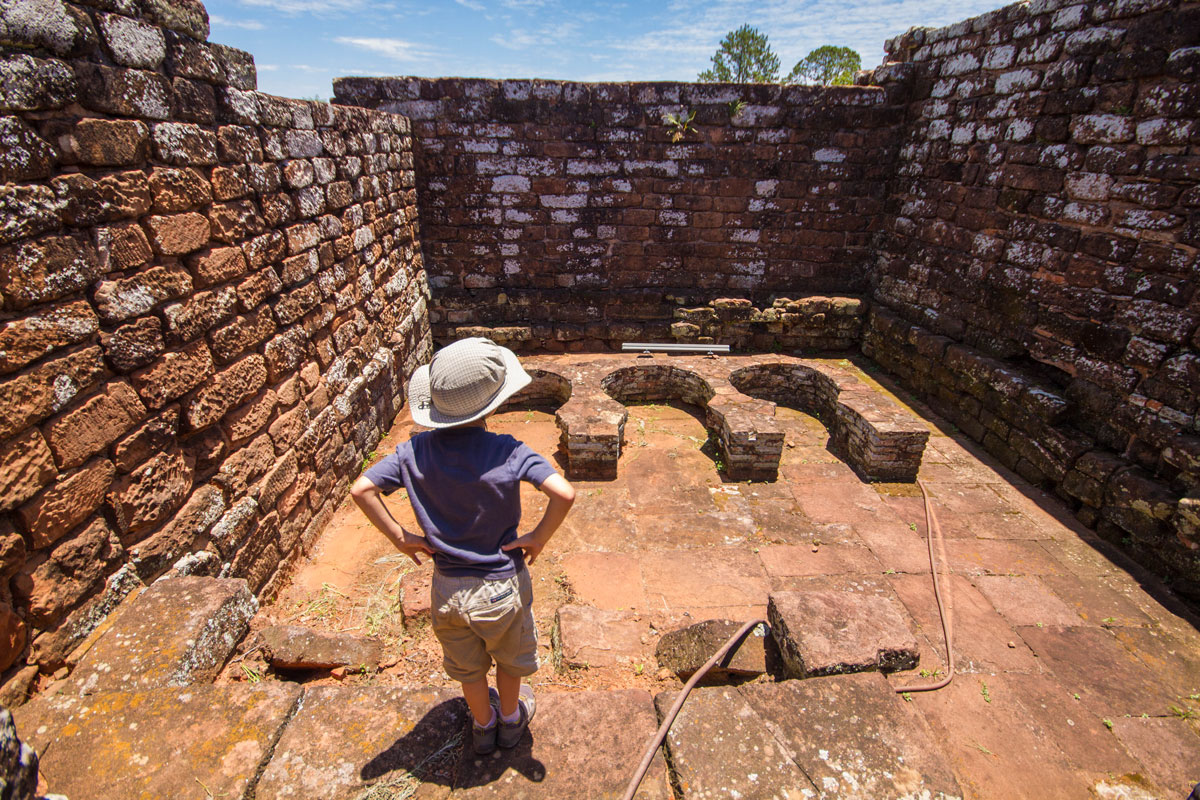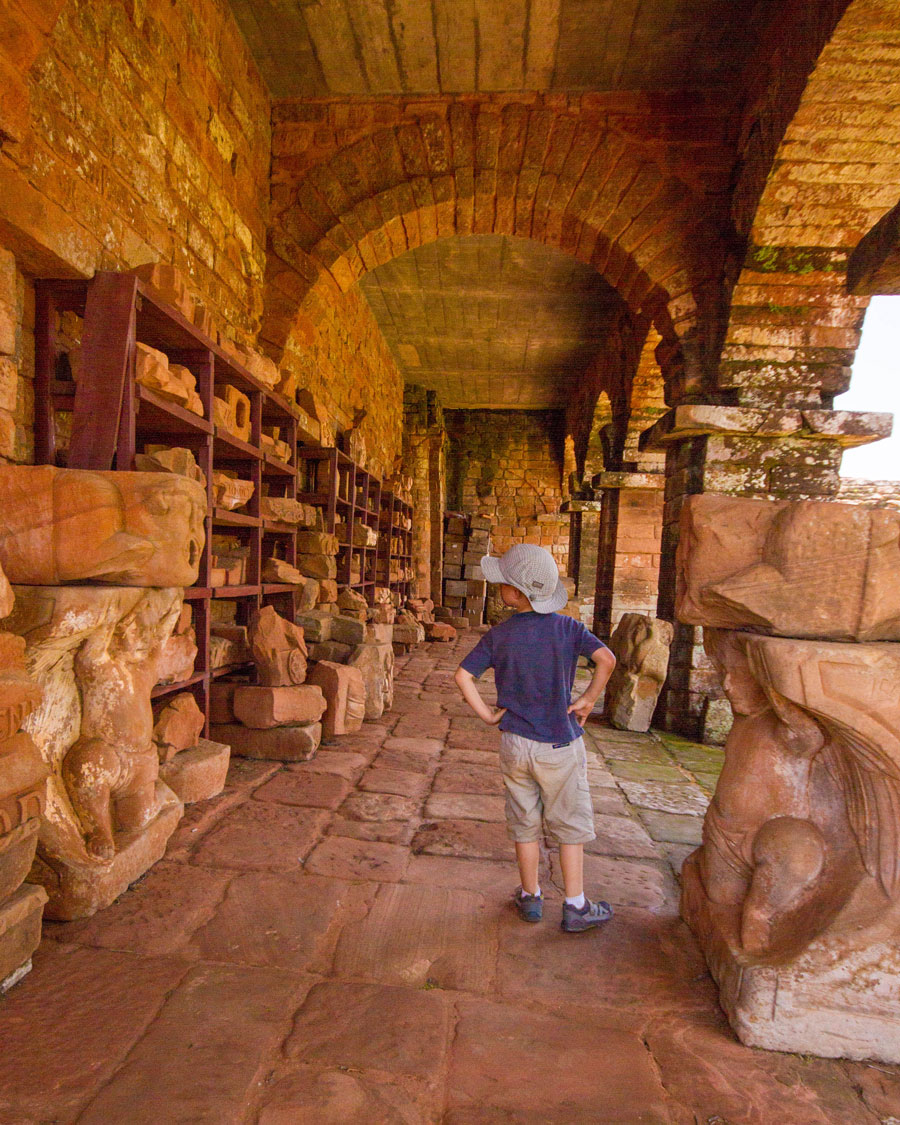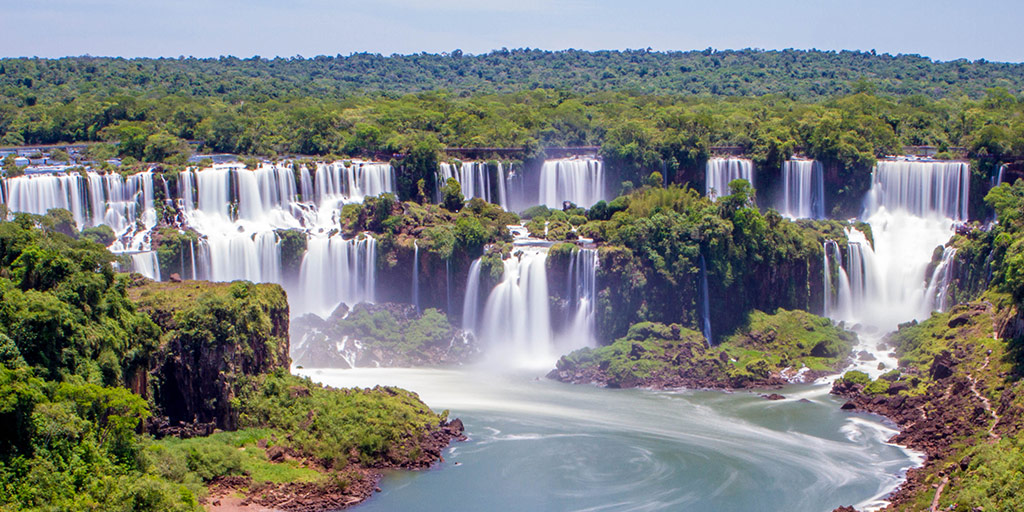Visiting the Jesuit Missions in Paraguay makes for an incredible day trip. The two main missions are full of history and culture.

We are suckers for historical ruins. The more remote and character-filled, the more we love them. In Portugal, the Moorish Castle in Sintracaptured our heart. While in Guatemala, it was the ruins of Tikal that had us lost in a time long since past. In South America, it was the Jesuit Missions in Paraguay that took us on a journey through time.
We were based in San Ignacio, Argentina for a few days and, being so close to the border, we got in touch with Michael, a San Ignacio tourism operator regarding getting into Paraguay to see the ruins. We can’t resist an opportunity to get another stamp in our passports!
Make sure to subscribe to our YouTube channel see all our latest videos!
This post may contain compensated links. For more information please read our disclaimer.
Getting to the ruins of Jesuit Missions in Paraguay with Kids
Table of Contents
In the morning, the incredible Jimmy the Aussie picked us up. He is an Australian expat of Argentinian roots. He built up an instant rapport with the boys and our group chatted amiably during the drive to the border. Jimmy regaled us with stories of his adventures and as we pulled up to the border station for the ferry to Paraguay, he hopped out to take care of the paperwork for us.
We boarded a small 18-car ferry and sat on the open upper deck to take in the views. The boys watched excitedly as we made the short crossing of the Parana river towards the border of Paraguay. Once we docked, the cars were unloaded and the paperwork handled for the visas on the Paraguay side. The ferry runs almost hourly.

Pro-Tip: There are regular bus services from Posadas in Argentina to the Misiones Department in Paraguay. Just request to stop within walking distance of the ruins.
Visiting the Mission de Jesus de Tavarrangue
After just under an hour on the road, passing through small towns and beautiful countryside, we pulled up to the first of the Jesuit Missions in Paraguay, Mission de Jesus de Tavarrangue.
The Mission of Jesus got its name as it was to be the largest of all the missions in the Misiones Department. Designed to be a replica of the Sanctuary of Loyola, in Spain. The mission is accessed by walking from the main entrance near a small museum with a miniature replica of the completed buildings.

Getting a taste of Matte
Jimmy and I had chatted about my fascination with the local custom of drinking Jerba Matte and spoke with one of the staff at the entrance who was kind enough to share his drink with me before we made our way onto the grounds. As we crossed through a small grove of trees, the entrance to the missions church came into view and the boys took off running, excited to explore the grounds.

Pro-Tip: The missions in Paraguay sit in wide open fields with very little shade. Make sure to lather up with sunscreen and bring plenty of water to keep hydrated.
The History of Mission de Jesus de Tavarrangue
The Reduccion de Jesus was founded back in 1685, but the current location was settled in 1760. The mission was never completed, and the Jesuits were expelled from Paraguay in 1767 by Brazilian invasions leading up to the Paraguayan War.
During the active time of the mission, a unique balance formed between the Aboriginals and the Jesuits. Whether that balance was of greater benefit to the Indigenous peoples is up for debate, but there is no doubt that loyalty existed between the two factions, with two Jesuits leading a village of thousands of Indigenous peoples.

Exploring Mission de Jesus de Tavarrangue with Kids
The mission itself is incredibly easy to explore. With wide-open expanses and well-trimmed grass to roll around on, they are a perfect playground for kids. The boys slalomed around the pillars of the Reduccion de Jesus (Jesus’ Mission).

The church would have been one of the biggest churches of the time at over 70M long and 24M wide! We also took the chance to let the boys scratch their photography itch. We love to let them take control of the cameras to see what kind of wild and fun angles they’ll come up with.

Exploring the Missions of La Santísima Trinidad de Paraná
While the ruins of Jesus de Tavarrangue were pristine due to their relatively young age, the ruins La Santisima Trinidad de Parana were a treasure chest of discovery. These ruins were far more complete, and the grounds far more expansive.
La Santisima Trinidad de Parana offered a complete picture that these missions were designed to be self-contained societies, existing with their own rules outside of normal colonial life.

The history of Missions of La Santísima Trinidad de Paraná
Originally built in 1706, the mission has a meeting plaza, two churches, a school, workshops and more. It is the more established of the two ruins, but, like Jesus de Tavarrangue, the Jesuits were expelled from the area in 1768.

Exploring Missions of La Santísima Trinidad de Paraná with Kids
The ruins of Trinidad are a treat to explore. Because the ruins are far more complete than the ruins of Jesus de Tavarrangue, it deserves a lot more time as well. The watchtower that serves as sentry over the village is a great starting point. While you can’t enter it, it is easy to imagine the views from its peak.

Nearby is the original church that served as the place of worship for the mission until the population grew past its ability to contain them all. The boys loved racing along the length of the building.

Shops and Statues
As we made our way towards the main cathedral, we strolled through the various workshops where the Indigenous peoples would build and forge the items needed to run the mission, including the massive bells that sat in the towers of the cathedral.

There is also a section that contains many of the archaeological finds from the ruins, including statues, facades and the thigh tiles used for the roofs of the structures. We learned that they were called “thigh tiles” because the clay pieces were actually shaped by being bent over the thighs of the workers.

Cathedral of Trinidad
The Cathedral in the Missions of La Santísima Trinidad de Paraná is nothing short of breathtaking. While not as large as that in Jesus de Tavarrangue, it has so much more in terms of artistry.

The tall walls still feature delicate arches, and even the remains of some of the statues can be seen mounted near the walls. The statues are all missing their heads, which were decapitated during the expulsion of the Jesuits and the ransacking of the missions.

We had to remind the boys not to walk down the middle of the cathedral. The floors were lined with the crypts of the remains of the village chiefs buried beneath the stone floors. There is also the remains of a crypt beneath the sacristy, however, it has long since been emptied.

Jesuit Missions in Paraguay with Kids as a Day Trip from San Ignacio, Argentina
Visiting the two missions in Paraguay made for an incredible day trip from San Ignacio, Argentina. San Ignacio is known for its own incredible Jesuit Mission, San Ignacio Mini. But it may leave you wanting more, so it’s great that these are so close by.
While the beautiful weather helped, the history and stress-free sightseeing in Paraguay made for a truly unforgettable experience. The region is largely untouched. The boys were able to explore the ruins exactly how they love to, by touching, climbing, smelling, and seeing everything that they wanted to. If you are in the region, it is well worth the time to visit for yourself.

Heading back to Argentina
As we met back up with Jimmy for our return to Argentina, our conversation drifted back towards Matte and how everyone in the area seems to drink it religiously. We were lucky enough to meet up with a friendly crowd on the ferry ride across the Parana river and before long, the group of us were sharing a drink of this delicious tea and discussing all the incredible things we had seen that day.

Wandering Wagars is a participant in the Amazon Services LLC Associates Program, an affiliate advertising program designed to provide a means for sites to earn advertising fees by advertising and linking to amazon.com, amazon.co.uk, amazon.ca. Amazon and the Amazon logo are trademarks of Amazon.com, Inc. or its affiliates.
You May Also Like To Read:

[ezcol_1half][/ezcol_1half] [ezcol_1half_end][/ezcol_1half_end]





KLAS LUNDSTRÖM
Friday 22nd of January 2021
Dear Kevin Wagar! I write to you because we are searching for a good oversight picture on the Jesuit missions i Paraguary. I am the editor of a book on Swedish mission history. We also include a shorter overview of international missions and there we also present the Jesuit missions in Paraguay with a short text and a picture. The fourth picture in this presentation above, under the heading "Visiting the Mission de Jesus de Tavarrangue" is just the best illustration we could find, so I would ask you for a permission to use it. The book is written in Swedish and has a limited circulation - only 1000 copies will be printed. We also struggle with a limited economy and try to keep the costs as low as possible, so either we ask to get it free or to buy it for a low fee.
Ref. Discovering the Ruins of Jesuit Missions in Paraguay with Kids, February 19, 2017.
Yours, Klas Lundström Ass. professor, Johannelund School of Theology, Uppsala, Sweden.
Kevin Wagar
Saturday 23rd of January 2021
Hello Klas,
Thank you for reaching out. I will contact you by email.
Mark
Sunday 27th of August 2017
Yes when I went to these ruins I thought they were great also. They are in perfect condition and there are no crowds or hassle!
Kevin Wagar
Monday 4th of September 2017
It is such a treat to visit a place that hasn't been discovered by the masses yet, isn't it!
Shem
Thursday 2nd of March 2017
I love exploring historical ruins, and they always photograph so well! Your photos look stunning and I hope I can see this for myself in Paraguay someday!
neha
Thursday 2nd of March 2017
You have captured some wonderful pictures of the ruins. We also like visiting these kind of places a lot. And on top of that, it looks like an offbeat place, can hardly see any crowd in your pictures. I will definitely check it out when I visit this part of the world
Kevin Wagar
Sunday 5th of March 2017
It was amazing, there were hardly any other people in either ruin
Sandy N Vyjay
Wednesday 1st of March 2017
This place has true scenic beauty. I strongly believe that ruins have a beauty of their own and the same applies here. Every architecture is so unique. Love the history behind this place.